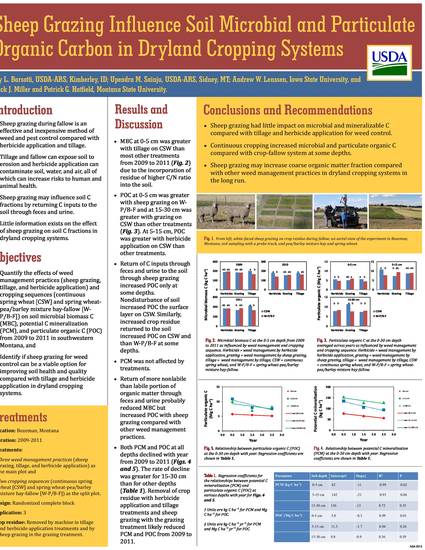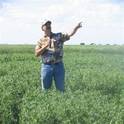
Presentation
Sheep Grazing Influence Soil Microbial and Particulate Organic Carbon in Dryland Cropping Systems
Agronomy Conference Proceedings and Presentations
Document Type
Poster
Disciplines
Publication Date
1-1-2015
Conference Title
ASA-CSSA-SSSA Annual Meeting
Conference Date
November 15-18, 2015
Geolocation
(44.977753, -93.26501080000003)
Abstract
Sheep grazing may influence soil C fractions by consuming crop residue and weeds and returning C through feces and urine to the soil. We examined the effect of sheep grazing compared with tillage and herbicide application for weed control on soil microbial biomass C (MBC), potential C mineralization (PCM), and particulate organic C (POC) in relation to soil organic C (SOC) at the 0-30 cm depth in a Blackmore silt loam under dryland cropping systems from 2009 to 2011 in southwestern Montana, USA. Treatments were three weed management practices (sheep grazing [grazing], herbicide application [chemical], and tillage [mechanical]) and two cropping sequences (continuous spring wheat [CSW] and spring wheat-pea/barley mixture hay-fallow [W-P/B-F]). The MBC at 0-5 cm was greater in mechanical with CSW than grazing with CSW or mechanical with W-P/B-F in 2010 and 2011. Averaged across years, POC at 0-5 cm was greater in grazing than chemical with W-P/B-F, at 5-15 cm was greater in chemical than grazing with CSW, and at 15-30 cm was greater in grazing than chemical and mechanical with CSW. The PCM/SOC ratio at 15-30 cm was greater in mechanical than grazing with CSW. At all depths, MBC, PCM, and POC decreased from 2009 to 2011 regardless of treatments, except for MBC in mechanical with CSW at 0-5 cm which increased. Lower proportion of labile than nonlabile organic matter returned to the soil through feces and urine probably reduced microbial biomass and activity, but increased coarse soil organic matter with sheep grazing compared with herbicide application and tillage. Sheep grazing may improve soil health and quality in the long term by enhancing microbial biomass and C storage compared with tillage and herbicide application for weed control under dryland cropping systems.
Rights
Works produced by employees of the U.S. Government as part of their official duties are not copyrighted within the U.S. The content of this document is not copyrighted.
Language
en
File Format
application/pdf
Citation Information
Upendra M. Sainju, Joy L. Barsotti, Andrew W. Lenssen, Zach J. Miller, et al.. "Sheep Grazing Influence Soil Microbial and Particulate Organic Carbon in Dryland Cropping Systems" Minneapolis, MN, United States(2015) Available at: http://works.bepress.com/andrew_lenssen/111/

This is a poster presented at the ASA-CSSA-SSSA Annual Meeting, Minneapolis, MN, November 15-18, 2015.